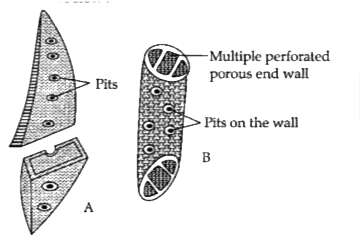Why is wood made up of xylem and not of phloem?
Step-by-Step Solution:
1. Understanding Wood Composition: Wood is primarily composed of xylem tissue, which is formed during the secondary growth of plants.
2. Role of Vascular Cambium: The vascular cambium is a layer of meristematic tissue that facilitates the growth of xylem and phloem. It is located between the xylem (inner side) and phloem (outer side).
3. Secondary Growth: During secondary growth, the vascular cambium produces secondary xylem towards the inside and secondary phloem towards the outside.
4. Characteristics of Xylem: Xylem is a strong and rigid tissue that is primarily responsible for the transport of water and minerals from the roots to the rest of the plant. It provides mechanical support to the plant structure.
5. Characteristics of Phloem: Phloem, on the other hand, is known as a "leaky" or soft tissue. It is responsible for the transport of nutrients and sugars throughout the plant but does not provide significant structural support.
6. Formation of Wood: As secondary xylem is produced, it accumulates and forms the wood, which is primarily composed of dead xylem cells. These cells are adapted for structural support.
7. Phloem's Role: The secondary phloem, while it is living and functional, does not contribute to the wood structure. It is sloughed off over time due to its soft nature, whereas the xylem remains intact and contributes to the overall strength of the plant.
8. Conclusion: Therefore, wood is made up of xylem and not phloem because xylem provides the necessary mechanical support and rigidity that wood is known for, while phloem serves a different function related to nutrient transport.
Topper's Solved these Questions
- ANATOMY OF FLOWERING PLANTS BOOK - ICSECHAPTER - ANATOMY OF FLOWERING PLANTS EXERCISE - Test Your Progress (HOTS)
4 Videos
- ANATOMY OF FLOWERING PLANTS BOOK - ICSECHAPTER - ANATOMY OF FLOWERING PLANTS EXERCISE - Ncert Exercises with Answers
12 Videos
- ANATOMY OF FLOWERING PLANTS BOOK - ICSECHAPTER - ANATOMY OF FLOWERING PLANTS EXERCISE - Test Your Progress (Very Short Answer Type Questions )
31 Videos
- ANATOMY OF FLOWERING PLANTS - PLANT TISSUESBOOK - ICSECHAPTER - ANATOMY OF FLOWERING PLANTS - PLANT TISSUESEXERCISE - REVIEW QUESTIONS (LONG ANSWER TYPE QUESTIONS)
20 Videos
Similar Questions
Given below are compounds of xylem and phloem. Study the same and answer the questions given below :


Why is xylem called wood ?
View SolutionThe movement of water and minerals in xylem and the movement of phloem sap in phloem is respectively
View SolutionGiven below are compounds of xylem and phloem. Study the same and answer the questions given below :


Draw a neat, labelled diagram of a phloem.
View SolutionGiven below are compounds of xylem and phloem. Study the same and answer the questions given below :


State the location of xylem.
View SolutionWhat are the differences between the transport of materials in xylem and phloem?
View SolutionMention if the statement is true (T) or false (F)
Veins of leaves have both xylem and phloem.
View Solution"The bells are made of metals and not of wood." Why?
View SolutionWhat is the chemical composition of of xylem and phloem sap ?
View SolutionThe type of arrangement of xylem and phloem on alternate radii is described as
View SolutionOn studying the T.S. of an organ, a student found , xylem and phloem are arranged in an alternate manner on different radii , this organ will be :
View Solution
